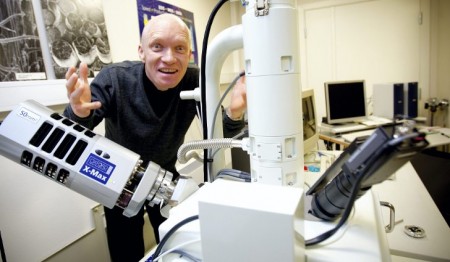Nov
18
Good Thermoelectric Devices Coming Soon
November 18, 2011 | 7 Comments
Dr. Ole Martin Løvvik of Oslo University’s Center for Materials Science and Nanotechnology in Norway has been studying the thermoelectric effect at the nanoscale for several years. Dr. Løvvik’s project in semiconductor physics is to develop oxidic thermoelectrics for generation of electricity from concentrated solar heat, waste heat from fuel cells and engines at high temperature. This will increase the efficiency and the design alternatives for solar as well as hydrogen and fossil-based power.
Løvvik said in an interview in the UK’s Engineer, the key to the problem is that a good thermoelectric material ought to have high thermal resistance but low electrical resistance. Therefore, perhaps counter-intuitively, it is important to prevent heat dissipation through the material.
The Norwegian team achieved this by introducing nanoscale barriers into various common semiconducting materials, which reflect waves of vibrating ‘hot’ energetic particles of certain frequencies.
Løvvik explains, “It looks easy on the outside, but on the inside the electrons are doing all the work. It’s essentially a heat engine but the working fluid is the electronic gas, because the electrons are free to move all around. It’s possible to choose your frequencies with care and then you can maintain the electronic conductivity while dramatically changing the heat dissipation – that’s what we aim for.
The fabrication method involves cooling down blocks of semiconducing materials to -196°C with liquid nitrogen to make them more brittle and less sticky, then grinding them down into nanoscale particles using a ‘mill’. Then particles are essentially compressed back together in a controlled fashion, leaving the essential nanoscale barriers within.
Here is Løvvik’s high moment – “We use the same kind of mill they use to make paint, it’s a well-established technique, it can be upscaled and it’s cheap, so that’s important,” he said.
Add in the calculations suggesting it could recover around 15 per cent of all energy losses in a variety of scenarios – and commercial production potential looks probable. The team is already in talks with a major automotive manufacturer (GM in the U.S.) with a view to placing the material in the exhausts of cars.
Løvvik grasps the significance, “This is just the starting point for using this technique to exploit the vast amount of waste heat that is available almost everywhere in society.”
Over half of all energy in the world is lost in useless waste heat. A car engine for example, only utilizes about 30 percent of the energy; the rest is lost as heat. Recovering 15% of the 70% earns back 10.5% for a total efficiency of 40.5%, a 33% improvement. Replacing the alternator in vehicles with a thermoelectric collector would also cut the load, saving even more. It would be like $3 gasoline getting $4 of work done.
The thermoelectric effect was discovered in 1821 and essentially describes the generation of a voltage arising from a temperature difference across a material, generally made up of two different metals. Here the Norwegians have managed to get worthwhile recovery efficiency with what seems to be a low cost monolithic material.
Cost and practicality have stopped thermoelectric devices from marketing successfully. It looks like Løvvik’s team has made it over the barrier.
The progress could be very significant if the production of material is low cost enough and the applications simple and robust. An enormous amount of heat is lost by energy intensive industry, business and in homes and transport. 15% doesn’t sound like a lot, but widely applied the results would be huge.
Keep in mind the Norwegian team is only at the first step. But the step looks to be commercial and marketable.
Comments
7 Comments so far



There are lots of exciting applications for this. Consider the mainly off grid rural developing world. Your cooking stove, even if it’s burning just cow dung, is smoke free and efficient, because its heat drives a fan. That alone would save the lives of millions who die each year of smoke inhalation in traditional kitchens in India and Africa.
Meanwhile your stove is charging a battery which can supply LED lights with power, and make it worthwhile to invest in a mobile phone, or a cheap computer.
Efficient cooking, lighting and communications off grid. A real dream. The sooner the better for tis idea!
Exciting news. But, Løvvik has a distinctly ‘mad scientist’ look in the picture!
Cpould this be a method for Rossi’s e-cat to convert its thermal output to electrical?
Definitely a mad scientist look or someone who is having a great time!
[…] New Energy and Fuel reports a breakthrough in thermoelectric technology. […]
Our friends from Next Big Future pointed to this additional detail on this work.
http://www.apollon.uio.no/vis/art/2011_4/artikler/temperature
Here’s publicity for a new model of a currently-marketed thermoelectric device – the biolite stove. http://biolitestove.com/BioLite.html . If it can be mass produced cheaply for developing world applications, it will improve the lives, even save the lives, of millions of people, will reduce the cost of off grid electricity, while reducing deforestation. This is without even the improvements in efficiency claimed by Lovik.
Thermoelectrics has astonishing potential.